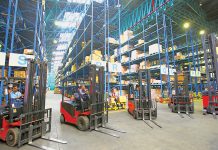Dealing with the pandemic crisis and a few policy reform initiatives, Tier-II & III cities have emerged as the preferred choices to shift base to for many key warehouse and logistics companies. Stalwarts in the logistics industry dwell on the current scenario.
Priyanshi Bana
From dilapidated buildings called ‘godowns’, to modern ‘warehouses’, the industry has come a long way. It has now become the backbone of the manufacturing and ever evolving e-commerce industry. The sector is evolving rapidly, with businesses and technology driving it, and is undergoing dynamic changes. With changes in the policies and infrastructural challenges, the warehousing industry is emerging as a pillar of strength to support the Indian economy.
According to a recent JLL report, warehousing demand is expected to grow around 160% to reach 35 million sq. ft. in 2021, making India a global manufacturing hub, which has led to warehousing clusters expanding rapidly beyond Tier-I cities and tapping on the potential of Tier-II and III cities. The change in the global supply chains has made firms re-invent their expansion strategies, focussing on providing efficient last-mile deliveries.
With increasing demand and manufacturing, the Tier-II and III cities such as Ludhiana, Ambala, Lucknow, Patna, Siliguri, Guwahati, Bhubaneswar, Vishakhapatnam, Vijayawada, Coimbatore, Kochi, Nagpur, Indore, Jaipur and Dholera, are fast emerging as Grade A warehousing clusters. Some of these cities have witnessed 20% growth in warehousing in FY2020, as indicated in a Knight Frank report. Obviously, there are advantages in terms of low rentals, availability of cheaper manpower, low capitalisation and others which are driving the growth in these non-Tier I cities.
Explaining the paradigm shift to these smaller towns, Balvinder Singh, Co-founder, Mex Storage Systems says, “Undoubtedly, the warehousing sector has come a long way and gained significant prominence over the past few years in terms of size and scope. With the change in time and continuous technological advancement, it has also become an indispensable part of the logistics network. If we talk about Tier-II & III cities, they indeed have a significant role in the warehousing sector, as it has helped companies meet their daily online orders and provide fast and safe delivery to different corners at cheaper rates than Tier-I cities.
Warehousing sector has absolutely evolved over the last year and especially after this COVID crisis, companies have understood the need for expanding their logistic facilities beyond Tier-I cities. The ongoing pandemic, lockdown restrictions, urbanisation and many other reasons have led companies to reform their supplying strategies for ensuring continuous supplying of orders and maintaining customers’ faith. More and more companies that earlier concentrated in Tier-I cities are now shifting to Tier-II & III cities. It has helped companies ensure effective order fulfilment within a stipulated time frame.
The shift has been made after certain policy initiatives, and it has some obvious advantages like low rental, low investment, and cheap labour etc. Besides being beneficial for the companies, it will also facilitate an improved distribution of wealth and growth in the rural sector.”
According to Gaurav Agrawal, Director, R Logistics Park, Raipur, “Warehousing sector has been growing tremendously over the last few years. We have seen a sharp increase in demand in Tier-II & III cities like Raipur. With GST completing four years in India, companies have now aligned their logistics roadmap and warehouses are now coming up in new and strategic locations.”
Another important factor which has led to the rise in demand of these Tier-II & III city warehouses is the exponential rise of the e-commerce and e-retail industries. Naveen Rawat, Director & Co-founder, Holisol Logistics says, “The outbreak of COVID-19 has led to the growth of e-commerce in the country, especially in Tier-II & Tier-III cities. Due to the lockdown and prevailing situation, more and more people are finding it safe and convenient to shop online instead of stepping out. This has driven the e-commerce players to scale up their presence in smaller cities to be able to serve the end consumer and increase their customer base. With rising demand, more and more brands especially those who are catering to essential products are expected to increase their inventory levels in Tier-II and Tier-III consumption markets. We are observing the rising need for ‘A’ Class facilities equipped with technology to provide seamless services to the customer.”
Adding to the cost involved, Sushant Nigam, International Air Cargo & AEO Consultant says, “Warehousing has much lower cost in the Tier-II & III cities and it connects the local and the small-time manufacturers with the distributors and retailers in a better way, benefitting all for speed, cost-effectiveness and the business profits.”
Explaining the contribution of the e-commerce industry, Singh adds, “The COVID outbreak has made a dramatic change in the e-commerce industry. E-commerce companies have seen a great rise in the orders from Tier-II & III cities than in Tier-I. However, with all the lockdown restrictions and ensuring safety, it is hard to provide timely supply, especially to the remotest part of the country. If a warehouse gets set up in more than one location, it becomes easier to fulfil the orders within the meantime. Setting up warehouses in Tier-II & III cities may help you reach more audience, provide timely delivery and ensure e-commerce order fulfilment. Warehousing industry can help in management of supply and meet demand within a promised time frame, allow companies handle alteration, return orders and timely processing and ensure better order management efficiency.”
Pointing to the changed dynamics of online shopping, Agrawal further adds, “One good thing to come out of this pandemic is a lot of people who were still not online have now come online. More and more people from smaller places are now placing orders online for stuff like groceries, FMCG etc. All this has been possible thanks to the superb supply chain management by the e-commerce companies. We are Raipur’s landlords to at least 8-10 of the leading e-commerce companies in India and seeing their working we can safely say that they will not stop until they reach the remotest pin code. These companies rely heavily on good warehouses which are built in strategic locations. So warehousing is very important for their growth in Tier-II & III cities.”
Explaining the benefits of setting up Grade-A warehouses in these cities, Alexandre Amine Soufiani, Managing Director, FM Logistics says, “As e-commerce marketplaces chase every serviceable pin code in the country, warehouses are being developed beyond the outskirts of major cities. For a long time, companies used to focus on land located outside the top few cities in order to store inventory and transport them easily to key consumption centres. Today, this is changing. With growing consumption in Tier-II and III cities and the launch of online-only brands, the demand across these cities has gone up significantly.
During the ongoing pandemic, delivering essential services to the masses became a necessity, which has resulted in a significant growth in the Tier-II and Tier-III warehousing markets. Though these markets are still at a nascent stage, they have huge growth potential. There has been a tremendous shift in consumer behaviour as the majority of customers across the country – even those in Tier-II and Tier-III cities, have resorted to online shopping. Customers today need to have access to their required products within the shortest period of time. In order to deal with such situations, companies have understood the importance of having a real-time pulse of the market and are investing in Grade-A warehousing facilities in smaller cities. This has helped them to cater to the rapidly increasing customer base in these cities.”
Further, expounding on the benefits, Sandeep Chadha, Managing Director, Pragati Warehouster said, “While the key eight metros are being saturated and there is an inundated demand for more warehousing centres it is but natural to look up to India’s upcoming centres to balance it out. The advantage would be quick turnaround time, lesser costs and a synchronised overall realm. Redundancy will be removed, and overall throughput shall be enhanced. With too many centres being the need of the hour, streaming it all could be a challenge. But then we have technology to our rescue, and we can overcome the bottleneck with the help of it. Automation, robotics, AI, machine learning and IoT are all being implemented to smooth it out. So I would say, there are more upsides than the hurdles in executing it on an industrial level and on a pan-India basis.”
According to Anshul Singhal, Managing Director, Welspun One Logistics, “With a surge in online shopping in Tier-II & III cities because of easy accessibility to internet, there has been a sharp increase in buying power and a rise in general awareness. With this, the demand across India for consumption through online buying has gone up significantly, hence giving rise to a demand for warehousing. As the demand for Grade-A warehousing is expected to increase consistently, further incentives towards private and institutional investment in warehousing and logistics parks through tax benefits, streamlined compliance and strengthening last-mile connectivity via support infrastructure like roadways, inter-state transport, and factory-to-port facilities, will greatly benefit the sector’s growth.”















